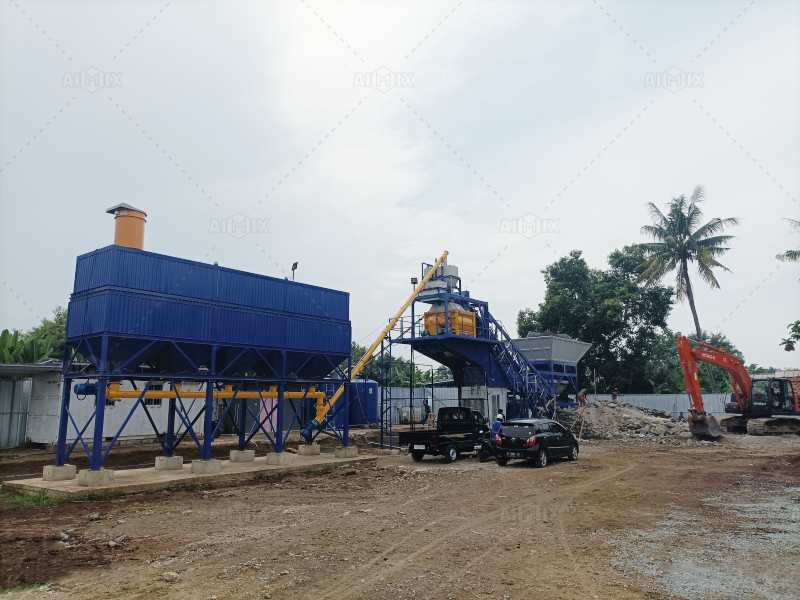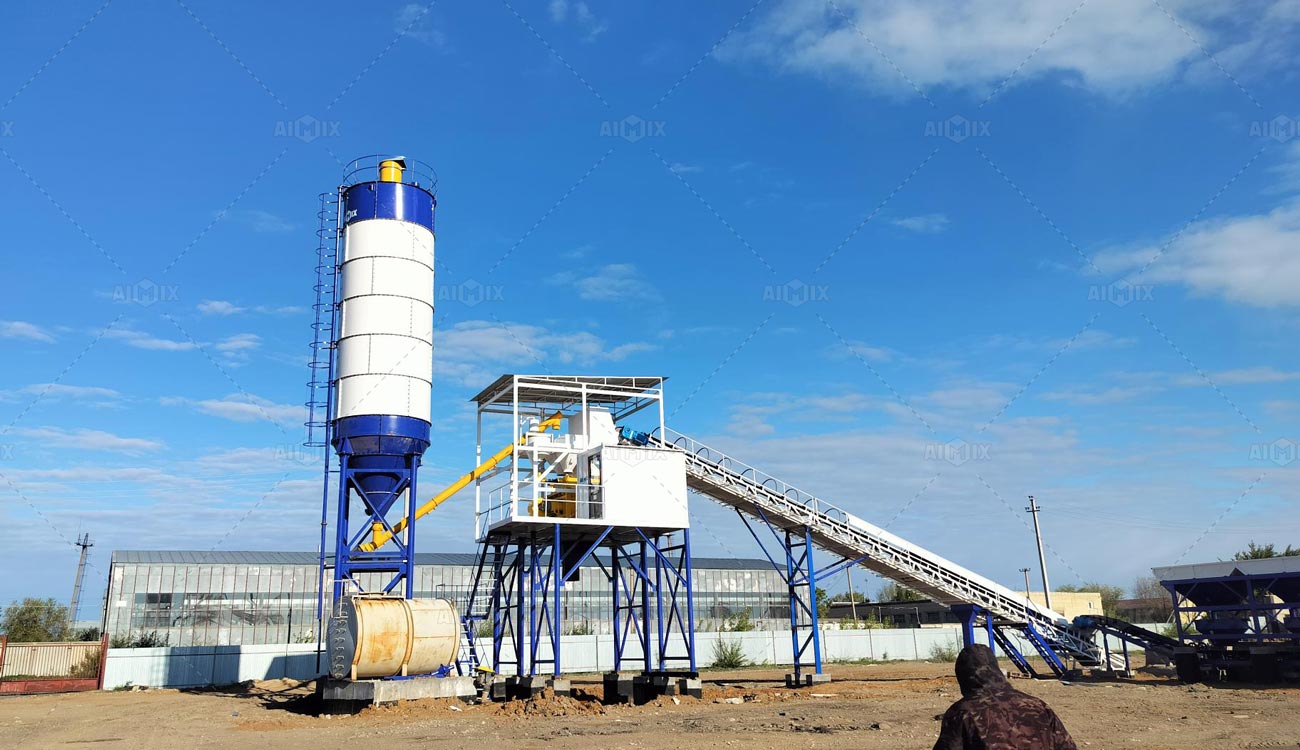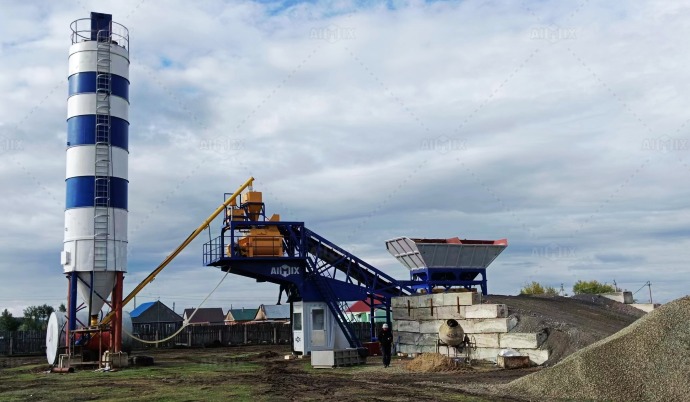For contractors, precast producers, and developers tackling smaller projects or seeking flexible production capabilities, investing in heavy machinery requires careful financial justification. An economical small concrete batching plant for sale presents a compelling opportunity to maximize Return on Investment (ROI) without the massive capital outlay and operational overhead of large stationary facilities. By strategically selecting the right portable concrete plants, mini concrete batching plant, or mobile concrete batch plant, businesses can unlock significant cost savings, operational flexibility, and new revenue streams. Understanding how these compact workhorses drive profitability is key to making a smart purchase.

1. The Foundation of Economy: Lower Initial Investment & Reduced Overheads
The most immediate impact on ROI comes from the drastically lower upfront costs compared to large-scale plants:
Lower Purchase Price: Small concrete batching plant for sale inherently require less material, simpler structures, and smaller components (mixers, bins, silos), translating directly into a more affordable price tag. This significantly reduces the initial capital barrier.
Minimal Site Preparation & Installation: Unlike massive stationary plants needing deep foundations, extensive utilities (high-voltage power), and significant site leveling, a mini concrete batching plant or portable concrete plants often require only a reasonably level, stable surface. Setup can frequently be measured in days, not weeks, saving on labor, equipment rental, and engineering fees.
Reduced Transportation Costs: Smaller size and weight mean lower costs for delivering the plant to your site, especially relevant for mobile concrete batch plant units designed for easy towing.
Lower Utility Consumption: Smaller motors for mixers, conveyors, and air compressors consume significantly less electricity. Reduced water needs (unless recycling is integrated) also contribute to lower ongoing utility bills.
Simplified Maintenance: Fewer complex components and smaller scale generally mean lower spare parts costs and potentially simpler (though no less important) maintenance routines, reducing downtime and repair expenses.
2. Driving Revenue: Flexibility, Niche Markets & Reduced Waste
Economy isn’t just about lower costs; it’s about smarter operations that boost revenue potential:
Project Versatility & Mobility: The core strength of a mobile concrete batch plant or highly portable concrete plants is their ability to move to the concrete. This eliminates costly transit-mix truck charges for:
Remote Job Sites: Building cabins, rural infrastructure, wind farms, pipelines.
Small/Scattered Projects: Residential driveways, foundations, swimming pools, landscaping features spread across a neighborhood or region.
Tight Urban Sites: Where space for a large plant or truck maneuvering is impossible. Produce exactly where needed.
Capturing Small-Batch & Specialty Mix Markets: Large plants often find small orders (< 1-2 cubic yards) or highly specialized mixes (colored, fiber-reinforced, specific permeability) uneconomical. A mini concrete batching plant is perfectly suited for these niche, higher-margin opportunities, serving homeowners, specialty contractors, or precast shops needing precise, small volumes.
Just-In-Time Production & Reduced Waste: Batch only what you need, precisely when you need it. This minimizes the risk of unused concrete hardening in the drum (a significant cost with transit mix) and eliminates disposal fees for waste concrete. Perfect for projects with unpredictable daily pour volumes.
Rental Income Potential: Owning a small concrete batching plant for sale that’s easily transportable opens the door to renting it out to other contractors for specific short-term projects, generating an additional income stream and further improving ROI.
Faster Project Start-Up: The speed of deploying a mobile concrete batch plant means getting concrete production operational much faster on a new site compared to setting up a permanent facility, allowing revenue generation to begin sooner.

3. Choosing the Right “Economical” Model: Key Considerations for ROI
Not all small plants are created equal in terms of delivering true value. Focus on these aspects:
Plant Type & Mobility:
Mobile Concrete Batch Plant (Trailer-Mounted): Highest mobility, ideal for frequent relocation between diverse sites. Best ROI for contractors with geographically dispersed, short-duration projects. Ensure robust trailer and easy setup.
Portable Concrete Plants (Skid/Module Mounted): Easily moved with a flatbed truck or lowboy, but require crane/forklift for placement. Offer a good balance of mobility and stability. Suitable for projects lasting weeks/months.
Mini Concrete Batching Plant (Small Stationary): Designed for semi-permanent placement but with a very small footprint. Highest output potential within the “small” category, best ROI for dedicated small precast yards, block makers, or fixed locations with steady, moderate demand.
Capacity & Output Match: Honestly assess your typical daily concrete needs. Overbuying capacity wastes capital; underbuying creates bottlenecks. Look for plants with capacities realistically matching your project sizes (e.g., 15m³/h to 35m³/h is common for “small”).
Core Quality & Durability: “Economical” should never mean “cheaply made.” Prioritize plants with:
Robust mixer design (pan or twin-shaft for small scale) using quality steel.
Reliable weighing systems (load cells for cement/water, belt scales or hoppers for aggregates).
Durable aggregate bins and frames. Cutting corners here leads to downtime and repair costs that destroy ROI.
Level of Automation:
Manual/Semi-Automatic: Lowest upfront cost, requires constant operator attention. Suitable for very low-volume, intermittent use. Higher labor cost per yard.
Fully Automatic (PLC Controlled): Higher initial cost, but dramatically improves batching accuracy, consistency, and reduces labor requirements per cubic yard. Delivers better quality concrete and higher effective output, often justifying the extra investment for consistent production. Crucial for maximizing ROI through efficiency.
Ease of Maintenance & Support: Choose a design with accessible components and good local dealer support for parts and service. Downtime is the enemy of ROI.

4. Beyond Purchase Price: Calculating True ROI
Maximizing ROI requires looking at the total financial picture over the plant’s lifespan:
Initial Investment: Purchase Price + Delivery + Installation/Setup.
Operational Costs (Per Cubic Meter/Yard): Electricity + Fuel (for loader/mobile plant) + Water + Raw Materials (Cement, Aggregates, Admixtures) + Labor + Maintenance & Repairs + Wear Parts Replacement.
Revenue Generated (Per Cubic Meter/Yard): Price charged for concrete produced.
Avoided Costs: Savings from eliminating transit-mix charges + Reduced waste disposal fees.
Additional Revenue: Rental income (if applicable).
Resale Value: Estimate the potential resale value of the well-maintained plant after your intended use period.
True ROI Formula Consideration:
(Total Revenue + Avoided Costs + Additional Revenue + Resale Value – Total Operational Costs – Initial Investment) / Initial Investment
An economical small concrete batching plant for sale shines by minimizing the “Initial Investment” and “Operational Costs” lines while maximizing “Avoided Costs” and enabling “Revenue Generation” in scenarios where larger plants or transit mix are impractical or too expensive.
Conclusion: Smart Investment for Strategic Growth
An economical small concrete batching plant for sale – whether a highly mobile concrete batch plant, versatile portable concrete plants, or efficient mini concrete batching plant – is far more than just a cheap alternative. It’s a strategic tool for maximizing ROI. By drastically lowering entry and operational costs, enabling revenue generation in underserved niches, reducing waste, and providing unparalleled flexibility, these compact units empower businesses to profitably tackle projects large plants cannot efficiently serve. The key to unlocking this value lies in carefully matching the plant type, capacity, and features to your specific operational needs and target markets, while never compromising on core durability and reliability. For the cost-conscious contractor or producer focused on smart growth, investing in the right small batch plant is a concrete step towards greater profitability.